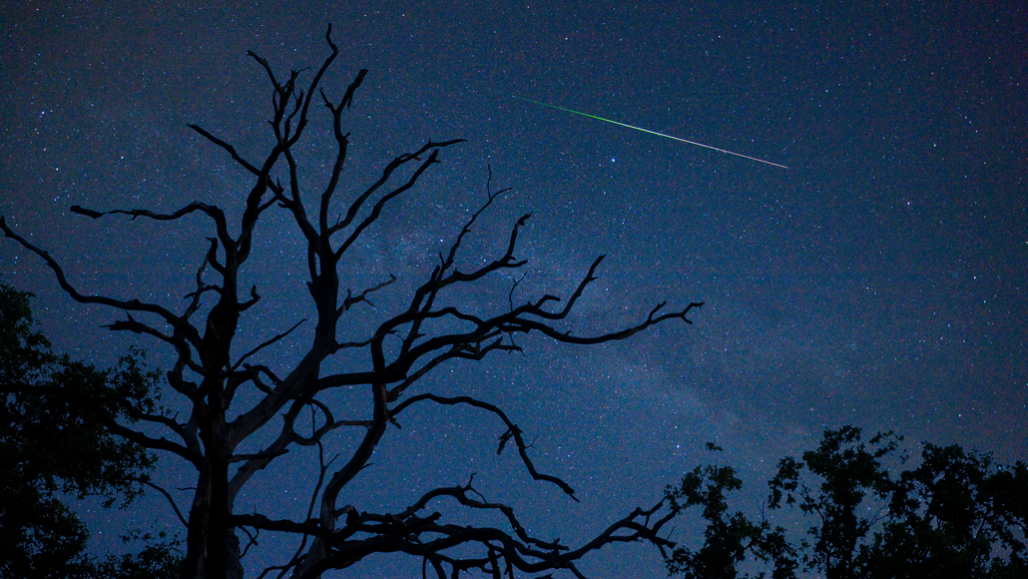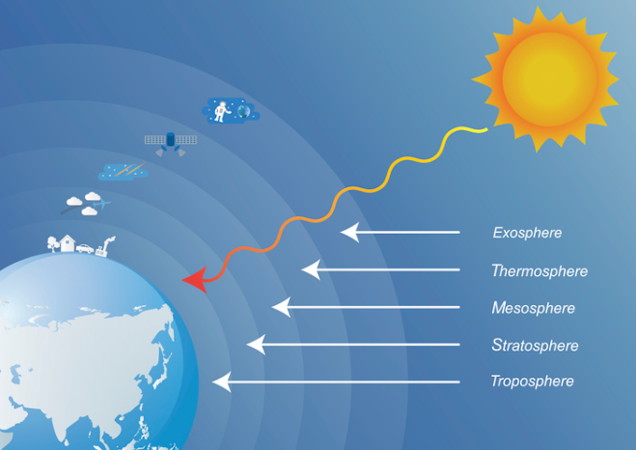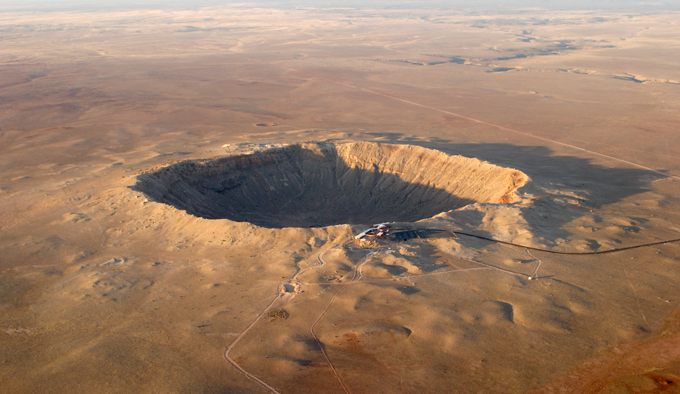Explainer: Understanding meteors and meteor showers
A big rock occasionally makes it to Earth, but most shooting stars simply burn up while still in the air

Here’s a shooting star, or tiny meteor, moving through Earth’s atmosphere. The streak of light this space rock left behind has shades of green and purple.
RobertHoetink/iStock/Getty Images Plus
Every once in a while, on a clear, dark night, a tiny streak of light flashes across the sky. Commonly called a shooting star, it’s actually a space rock — usually a quite small one. It creates light as its friction with Earth’s atmosphere causes its outer surface to catch fire and burn. At certain times of year, a reliable “shower” of these rocks can enter the upper atmosphere, creating a fleeting light show.
Bigger incoming rocks can pass all the way through the atmosphere, creating a sonic boom and trail of falling rocky debris.
So how big are these rocks and where do they come from? The simple answer is, it varies — widely. They tend to be what’s left in the wake of comets or space junk. Some may even be asteroids. That last type can be plenty big enough to pose a lethal risk to anything in their path.
Most, however, are silent, high-flying shooting stars. They enter the air as pebbles about the size of a pea. That means you could stow an entire locally viewed meteor shower in your backpack.
The source of a meteor shower will depend on which one you’re watching. Each tends to take place at about the same time each year — when Earth plows through some long-lasting field of debris. This happens at the same point in our planet’s annual orbit around the sun.
It’s kind of like driving on a warm summer day when your car enters a swarm of bugs. Even if the bugs are hovering and relatively still, their collision with your windshield will yield a loud splat (and leave a nasty streak on the glass). When a large enough meteor explodes in the lower atmosphere, it can cause a loud boom, depending on its size. It also sends a streak of light into the sky.

Earth’s gravity tugs at any nearby space rocks. As they get pulled into the upper atmosphere, they encounter drag. This friction releases an enormous amount of heat, igniting the meteor. The resulting fiery blaze can display a range of colors.
Every meteor shower has a radiant. That’s a point in the sky from which all the meteors appear to come. It’s the direction Earth bulldozes through the debris stream. So the planet strikes individual rocks head-on from that angle. If you look right at the radiant, you’ll see only a quick flash of light. But meteors that you catch while looking at a right angle (sideways) to the radiant will have long, vibrant tails.
Think about it like driving through a snowstorm at night. Imagine looking forward through the windshield. All the snowflakes seem to be heading straight at you because you’re moving straight at them. But gaze out the left or right window and the falling flakes will look like soft, white specks of light buzzing by. That’s because you’re moving parallel to the flakes’ motion.
Where do their colors come from?
Every meteor streak has its own unique character. So do the showers.
December’s Geminids are the most spectacular of all. They blaze emerald green, pink and violet. The August Perseid shower sends streaks of pink, lime green and purple. They flash across the sky in the blink of an eye. The Orionids in October are faster still but dimmer. Their streaks have a soft whitish-orange shimmer.
Two processes account for those hues.
As a meteor hurtles through the vacuum of space, there’s nothing to slow the extraterrestrial rock down. But once it encounters air resistance at the edge of Earth’s mesosphere, some 80.5 kilometers (50 miles) up, the rock gets hot. Enormously hot! That heat eventually causes the rock to burn. Its flames will have different colors, depending on the rock’s composition. Its elemental recipe determines the color of its glow. Metallic elements tend to burn brightest.
Researchers with the Astronomical Institute of the Academy of Sciences of the Czech Republic studied this in 2008. They looked at Geminid showers between 2004 and 2006. The “meteors were observed by image-intensified video cameras,” they reported. Then they applied a process called spectroscopy (Spek-TROS-koh-pee), which looks at how materials interact with light or emit light. This showed that some of the burning rock had been rich in magnesium, sodium and iron. The Perseids in August showed evidence of silicon and calcium, too.
If all these elements sound familiar, that’s because you’ve likely seen them on the back label of your breakfast cereal. Froot Loops contain them all. But that doesn’t mean dumping a bowl of Lucky Charms out your second-floor window will trigger a meteor shower. Indeed, speed is as important as the rocks’ ingredients.
As a meteor speeds through the atmosphere, it compresses the cushion of air trapped ahead of it. That “air pillow” is squeezed so much that it heats. When molecules absorb enough energy (here, heat), they can become excited — in a physical sense (not an emotional one). Afterward, they’ll release packets of light known as photons. The more energy going in, the more energetic the light that is later released. Higher energy photons will emit light having a higher frequency — also known as a higher wavelength. Purple light has a higher frequency than red. Ultraviolet light has a higher frequency than infrared.

Because the Geminids are slower, their light is mainly green. But even after a meteor has passed, it takes a while for the air molecules’ energy level to fall back to normal. That’s why a shimmering tail of light remains. That light also may be accompanied by smoke.
It’s very rare for a meteor to survive and crash into the ground. On average, one basketball-sized meteor falls to Earth’s surface each month.
To reach the ground, it must start out big enough so that it doesn’t burn completely during its trek through the atmosphere. One space-boulder crashed down just west of Detroit, Mich., in January 2018. Nearly 50,000 years ago, a far bigger one excavated 175 million tons of rock in what is now Arizona. The Barringer crater it left behind is nearly 1.6 kilometers (1 mile) wide and 174 meters (570 feet) deep.
Meteors that survive to reach the lower atmosphere hit more air resistance and as a result burn very bright. These are termed fireballs. The December Geminid showers and August’s Perseids produce large numbers of fireballs.
Bill Cooke heads NASA’s Meteoroid Environment Office. In this YouTube video he explains the difference between meteoroids, meteorites and fireballs.
How predictable are shower forecasts?
Weather permitting, people can see meteor showers many times a year. The Geminids’ peak shower spans several nights around the second week of December. Its light streaks tend to be bright, offering some of the best viewing of the year.
The Quadrantids arrive every January. They boast large numbers of shooting stars. In some years, people at many locations can see up to 100 per hour. But such peaks last only a few hours.
Debris left by Halley’s Comet is the source of two showers. The first, in May, is known as the Eta Aquarid shower. The October Orionids is the second. (Halley’s Comet last swept through the night sky in 1986. It won’t be back until 2061.)
The Areitid shower peaks around June 7th. It can bring more than 50 shooting stars per hour. That makes for comfortable warm viewing in the Northern Hemisphere. One might think that would make these showers widely viewed. In fact, they aren’t. Their radiant is so close to the sun that they are best seen right before sunset or sunrise. And because they are competing against that sunlight, only the brightest of the meteors will be visible. Plus, they mostly shower during the day. So unless a total solar eclipse blocks out the sun, they’ll zip through the skies unseen.
The August Perseid shower tends to be the most popular. It can send some 75 to 100 colorful meteors per hour across the sky. And the viewing will be summer warm in the Northern Hemisphere.
A handful of other lackluster meteor showers dot the night skies in other months, such as the Leonids each November. During its peak, that shower usually issues only about 15 meteors per hour. But even the Leonids can sometimes offer surprises.
In 1966, this usual dud of a shower started our pretty quiet. Cloud cover socked in the East Coast. Out West, only the occasional few blips of light confirmed the Leonids had arrived. As a result, most stargazers went to bed disappointed. Back then, 10-year-old Joe Rao was among them. Now a meteorologist, he has never forgotten hearing what he missed that night.
After 5 a.m., the sky seemed to explode. A torrential downpour of meteors sent more than 150,000 streaks of light across the sky in a single hour. That comes to more than 50 per second. After 90 incredible minutes, it was over. Such “meteor storms” develop when Earth’s orbit cuts through a trail of dense debris left by a comet or asteroid.
What causes it? A large fragment likely broke off some huge rock, perhaps shattering in the process. That left a narrow and extremely dense cluster of shards. Once every 33 years or so, Earth passes through one of these pockets to create a Leonid storm.
What if it’s cloudy?
Clouds can easily spoil the show from Earth’s surface. But that doesn’t mean the fun is ruined. NASA has a radar “listening station” for meteors in Huntsville, Ala. It lets anyone tune in to hear the blips as the shooting stars zip through the atmosphere. The radar signals are converted to sound waves. It’s best to listen for these during what would be Alabama’s predawn hours. That’s when more meteors enter the atmosphere — and do it with a greater velocity. This makes them easier to resolve on NASA instruments. And subsequently, you have greater odds of hearing the agency’s so-called “meteor radar.”
NASA is currently working on this system (so it is now unavailable). Meanwhile, another antenna in Washington, D.C., offers an alternative portal as a way to listen in.







